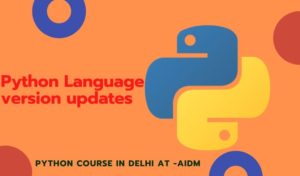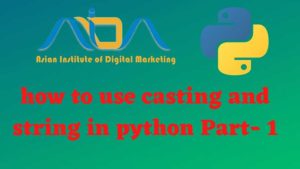AIDM is presenting a new post in the series of python course online for beginners. Being a leading institute for python training in Delhi, we have expert trainers of python programming language, who have a vast knowledge of their subject. This post is collective information provided by all of them. So let’s dive in the deep ocean of python concept.
No object-oriented programming language could be worthy to take a look at or use if it did not assist inheritance. Inheritance was invented in 1969 for Simula. Python not solely helps inheritance however multiple inheritances as properly. Typically talking, inheritance is the mechanism of deriving new lessons from current ones.
By doing this, we get a hierarchy of lessons. In most class-based object-oriented languages, an object created by means of inheritance (a “Child object”) acquires all, – although there are exceptions in some programming languages, – of the properties and behaviours of the mum or dad object.
Join our python course in Delhi and become a successful Python developer of the industry.
Inheritance permits programmers to create lessons which can be constructed upon current lessons, and this permits a category created by means of inheritance to inherit the attributes and strategies of the mum or dad class. Which means that inheritance helps code reusability.
The strategies or typically talking the software program inherited by a subclass is taken into account to be reused within the subclass. The relationships of objects or lessons by means of inheritance give rise to a directed graph.
Python Institute in Laxmi Nagar is a leading python training centre, where a brilliant team of python experts is here to teach you.

The category from which a category inherits is named the mum or dad or superclass. A category which inherits from a superclass is named a subclass, additionally referred to as inheritor class or baby class. Superclasses are generally referred to as ancestors as properly. There exists a hierarchical relationship between lessons. It is just like relationships or categorizations that we all know from actual life. Take into consideration autos, for instance. Bikes, vehicles, buses and vans are autos.
Decide-ups, vans, sports activities vehicles, convertibles and property vehicles are all vehicles and by being vehicles they’re autos as properly. We may implement a car class in Python, which could have strategies like speed up and brake. Vehicles, Buses and Vans and Bikes could be carried out as subclasses which are able to inherit these strategies from the car.
Syntax of Inheritance in Python
The syntax for a subclass definition appears like this:
class DerivedClassName(BaseClassName):
pass
As an alternative to the move assertion, there might be strategies and attributes like in all different lessons. The identify Base Class Name has to be defined in a scope containing the derived class definition.
Now we’re prepared for an easy inheritance instance with Python code.
Search python classes near me on Google and you will see our official website with the name of AIDM. Just click on that and your will land on the best page, where all the concepts in python language are discussed.
It will be good if you learn Data Science course in delhi and artificial intelligence course in delhi yourself by joining the Django training in delhi
The distinction between kind and Inheritance
You also need to take note of the next information, which we identified in different sections of our Python tutorial as properly. Individuals ceaselessly ask the place the distinction between checking the sort through the sort perform or the perform Inheritance lies. The distinction could be seen within the following code. We see that Inheritance returns True if we examine an object both with the category it belongs to or with the superclass. Whereas the equality operator solely returns True, if we examine an object with its personal class.
x = Robotic(“Marvin”)
y = PhysicianRobot(“James”)
print(Inheritance(x, Robotic), Inheritance(y, Robotic))
print(Inheritance(x, PhysicianRobot))
print(Inheritance(y, PhysicianRobot))
print(kind(y) == Robotic, kind(y) == PhysicianRobot)
True True
False
True
False True
That is even true for arbitrary ancestors of the category within the inheritance line:
class A:
pass
class B(A):
pass
class C(B):
pass
x = C()
print(Inheritance(x, A))
True
Now it must be clear, why PEP 8, the official Fashion Information for Python code, says: “Object kind comparisons ought to at all times use Inheritance () as a substitute of evaluating varieties instantly.” So this is a glimpse of the topic inheritance in a python programming language. If you want to get more information or become a master of python industry, you can start your career with AIDM, which is the latest Python Course in Laxmi Nagar.
Recommended blog:

- Number system, random module, math library, decimal in the python programming language
- Variable and datatypes work and behaviours in python language
- Python setup and a basic understanding of python language
- How to use casting and string in python
- Use of Boolean Datatype and Python Operators
- Use case of the tuple in python difference between list and tuple
- Python Sets And Dictionaries Python Lists, Python Sets & Dictionary
- Difference Between For and While Loop In Python
- What Are The 3 Types Of Loops In Python For Loop In Python With Condition







